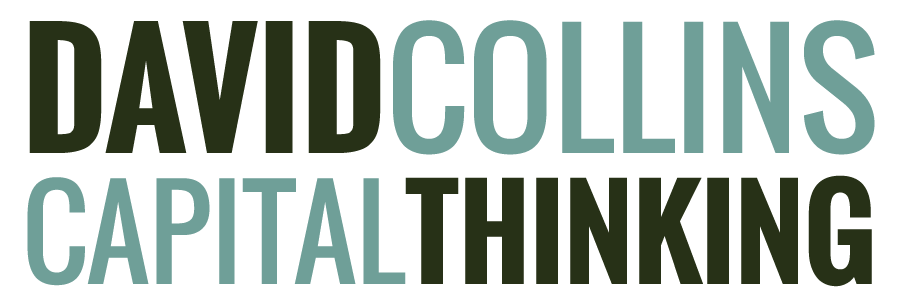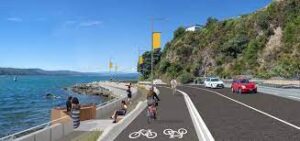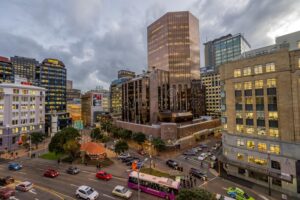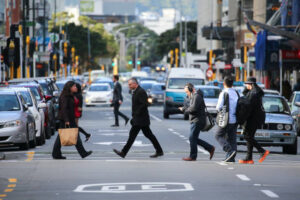Let’s Get Wellington Moving (LGWM) and the Wellington City Council (WCC) have agreed on the most radical move to ban all cars from the Golden Mile and side streets. This has been hailed as a positive and bold move for Wellington. Most respondents were in favour of this idea, but at what cost to businesses, the elderly and families who want to come into central Wellington?
I was told that when Heather Du Plessis-Allan interviewed Nick Mills and was asked what impact this decision would have on his business, he was nearly in tears when he replied. He also said, “Why are they trying to hold the city from growing? It’s ludicrous. They do everything they can to stop people getting into the city. It will just make people think twice about coming into town” (Dominion Post, 22 June 2021). LGWM and WCC have simply shafted businesses in central Wellington.
Removing cars from only the Golden Mile may not be an issue as only a few cars travel down Manners St, Willis St or Lambton Quay (regardless of what the anti-car brigade says). The problem is Courtenay Place which is a main thoroughfare for traffic turning into Tory St and Taranaki St, as well as people coming from Cambridge Tce and Dixon St, and the several parks along this stretch of road. These options will now be gone. This will be similar to what I experienced in Melbourne. Swanston St is now car free and only trams travel on this street. Pedestrians still use the footpaths. Removing cars from Swanston St has created major traffic problems. When staying at the Grand Mercure on Swanston St, it was very problematic for my taxi driver to get us to our hotel. In addition, when we came back late one evening from dinner after visiting family in the suburbs, my taxi could not even get us close to our hotel and we had to walk nearly a kilometre. It was chaos. The point is that the potential exists for the same to happen in Wellington, in that cross traffic will simply become congested and gridlocked.
The articles in the Dominion Post of 17 June 2021 state that between 100 to 200 carparks will be lost. This is not necessarily true, as I have written previously. The likely number is between 200 and 300 carparks. Removing cars from the side streets including Brandon, Panama, Blair and Allen streets for example are nonsensical and very damaging to retail, entertainment and related businesses. Morten Gjerde from Victoria University’s faculty of architecture stated that Copenhagen has successfully pushed to remove car parking from the central city which has made for a better environment for walking and shopping (Dominion Post, 22 June 2021). However, Copenhagen is a more compact city (88sq km) and a population of 603,000, while Wellington has a population of 215,000, (and a greater area of 444sq km and a metropolitan population of 485,000).
There seems to be no logical reason for this move. There are benefits other than to remove cars from the city centre at the commercial expense of the city. I suppose that is the whole point of this radical move. It is not commercially based, but as I have said many times, a purely ideologically driven move in the hope to reduce carbon emissions, and supposedly free up the city of congestion (in reality the Golden Mile and side streets are not contributing to congestion – it is the through roads and State Highway One that are the problems. Removing cars from the Golden Mile will not actually address this).
A surveyed commissioned during the consultation process concluded that 22% of retail spending was by people who accessed the area using cars (Dominion Post 17 June 2021). Bizarrely, Siobhan Procter (Programme Director for LGWM) stated the removal of cars would have very little impact on retail. Hello!! you have just removed 22% of a retailer’s income, that is a massive hit to the profitability of all those businesses. In addition, more people are working from home and the government is now building sub-offices in Porirua and the Hutt Valley to accommodate those who live in these areas. Thus, less foot traffic in central Wellington. Wellington retail and entertainment spending is already reduced. Thus, government policy to accommodate staff out in the outer suburbs, the removal of cars and changing working habits due to COVID-19 will potentially have a substantial impact on central Wellington. For example, my former company now has remote access for staff to work at home, with up to half of the staff working from home at any one time.
To overcome these problems, city planners must increase foot traffic in central Wellington by intensification and making the city vibrant and safe. Yet, there is already conflict with the spatial plan for central Wellington in that residents are trying to protect their inner suburbs from urban intensification, while at the same time councillors including Tamatha Paul want to change dramatically the characterisation of these suburbs with housing intensification (Dominion Post, 17 June 2021). Here lies the very problem of what Wellington will look like and/or whether Wellington can meet its need to intensify the city centre and what this will mean to the character of the city. This is a completely different discussion.
The reason the Viaduct Basin, Britomart and the Wynyard Quarters have worked is because of the city’s inner population and easy access to downtown Auckland. (Does Wellington want a series of high-rise apartment blocks lining the landscape like Auckland?). On the other hand, Manners Mall in Wellington failed on these counts, as did the Onehunga Mall experiment because of a lack of population density to support the mall and it was just too long. That currently sounds a bit like the Golden Mile experiment with a cost of $75 million.
As my daughter said, “I’m not coming into Wellington on a train with the kids to go shopping when I can drive to North City”. Why would I drive into central Wellington to park miles away to go to Courtenay Place for a beer and dinner when I can go to my local pub and restaurant in Thorndon? Catching the bus into town does not work for me either, it goes the wrong way. Catching a taxi or Uber just adds to the expense and still does not get me to where I want to go (as they will have to drop me off miles away). Hence, those like me and my daughter must be replaced by others and that is going to take a long time to happen, if at all.
Finally, I will leave the last word to Barrie Saunders who has written an excellent blog on this matter, and I quote;
“…Wellington has just 200,000 people, with a daily workforce arriving from neighbouring cities, some of whom also shop here on the weekends. This is a very modest population compared with say Copenhagen City (pop 800,000) and the recently referenced San Francisco area, pop of 890,000, and the San Francisco-Bay Area 7.7 million.
The “Mile” (actually much longer) is a long street for retail shopping and we must be realistic with our expectations. Townsville Queensland is an object lesson in CBD planning gone wrong. It has a population of around 200,000 and some strong suburban shopping centres. In 1979 it made Flinders Street (its CBD main street) into a mall without cars and the CBD went down-hill not long afterwards. Cars are now allowed back. I have visited Townsville’s Flinders Mall most years since 1993 and have noticed the damage that was done and the costs of rectifying it. While one can argue about which cities are relevant to Wellington, I believe Townsville is more appropriate than San Francisco and Copenhagen”.



